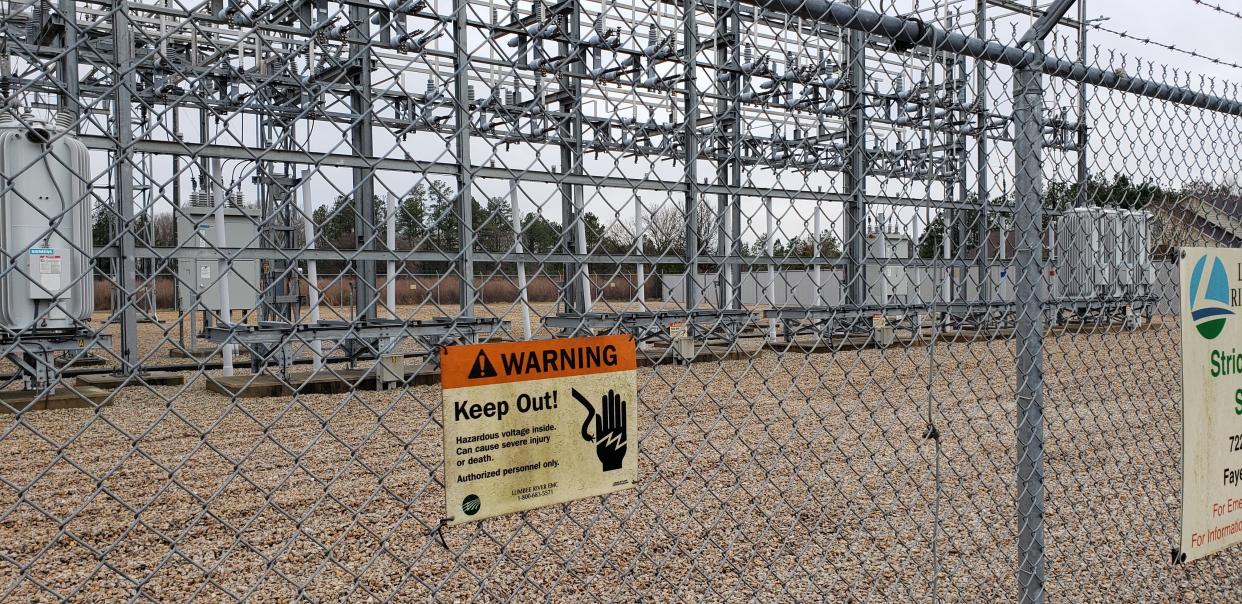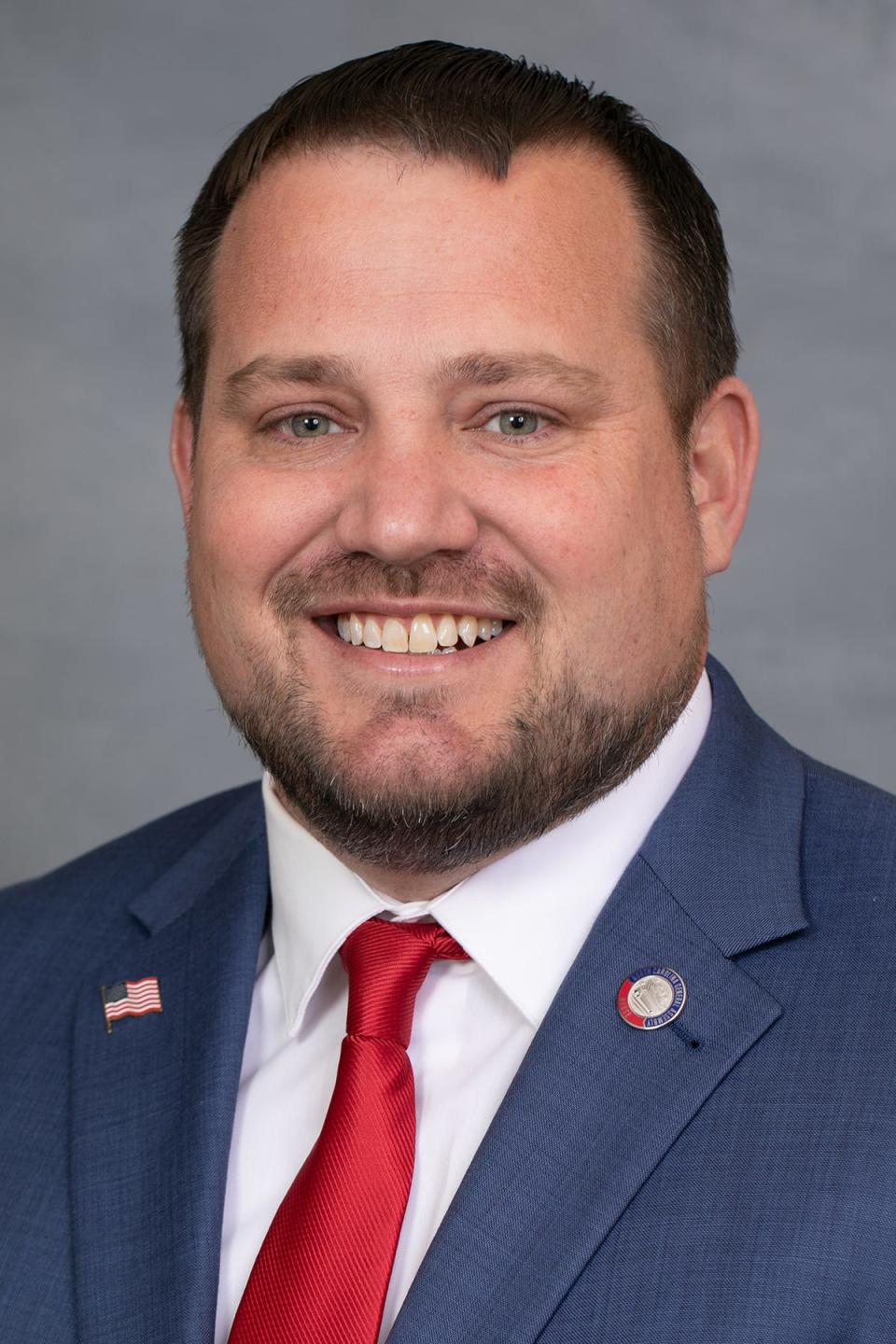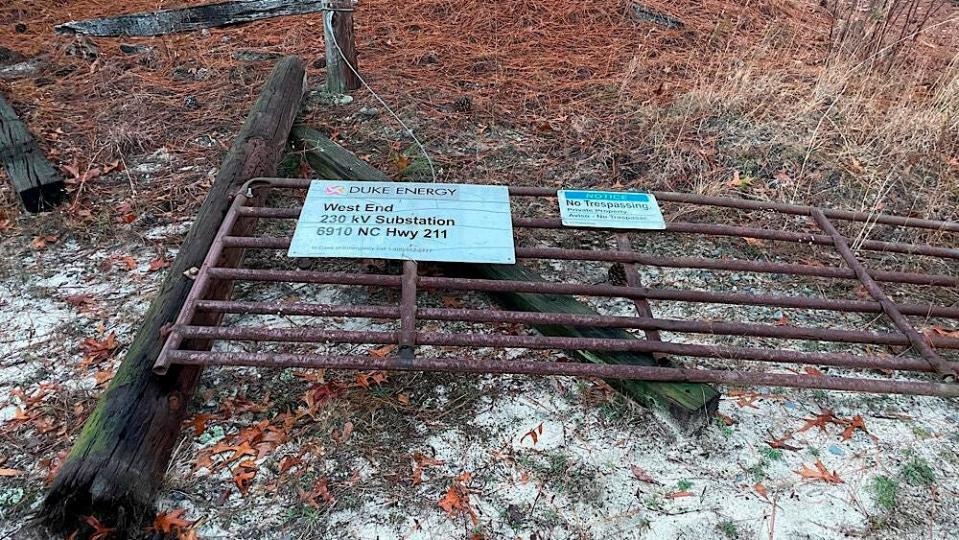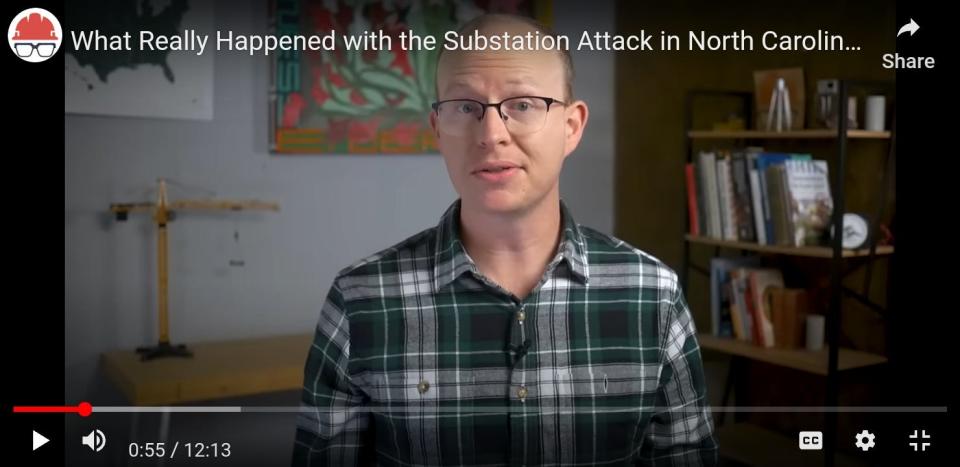Pitts: As Moore Co. power grid attacks go viral on YouTube, NC hunts solutions

Years ago, I bought a yellow convertible.
Before then, I would have told you almost no one had a yellow car.
But immediately after my purchase, I started to see many more yellow cars.
More:In light of Moore Co. attacks, how safe are Fayetteville area substations?
Now — in the wake of the Dec. 3 gun attacks on two substations in Moore County — I feel the same way about electrical substations. The crime put 45,000 homes and businesses in the dark for four days.
More than two months later there have been no arrests. I was told by the Moore County Sheriff's Office there were no new updates. Other investigating agencies include the Federal Bureau of Investigation and the State Bureau of Investigation.
More:'Intentional, willful and malicious': 40K without power after substation attacks in Moore County
There is still a $75,000 collective reward offered by local and state officials and Duke Energy, which owns the stations.
In January, someone shot up a substation in Randolph County. There were no outages, but that crime, too, is unsolved. The FBI is offering $25,000 for information on either the Moore or Randolph attacks.
More:'Intentional, willful and malicious': 40K without power after substation attacks in Moore County
The nature of these crimes is that the attacks may remain unsolved. I hope not. But people should steel themselves for at least that possibility. There have been no arrests in the 2013 sniper attack at a substation in Coyote, California, a crime that first put federal officials on high alert about the vulnerability of the power grid to attack.
Helping law enforcement catch the perpetrators of these crimes is one motivation behind a new bill proposed by N.C. Rep. Ben Moss, a Republican who represents Moore and Richmond counties.
Moss’ Energy Security Act (HB 21) would require public utility providers to “continuously operate” 24/7 security at their power substations. The bill is currently in House committees.

Moss told me Friday that the 24-hour security could come in a variety of ways.
“We have modern technology now where we can use motion detectors, sound detectors, lighting and in some cases barriers (depending on) the substation,” he said. “It’s not a one-size-fits-all when it comes to security, some need more security than others.”
More:Abortion, gambling, marijuana and shot-up power stations — new NC laws on the horizon
He said adding this kind of security could help law enforcement catch perpetrators “in a timely manner.
“I think they need some methods to help them with catching these people.”
Meanwhile, Senate Bill 58 was introduced in the state Senate last week; it would increase charges and impose heavier penalties on people who commit such crimes. Moss praised the action and said he had considered adding similar measures to his own bill.

Meanwhile, he said he had been talking to Duke Energy and other power providers.
“This bill is just very general in nature. It’s open-ended,” he said. “Because I’m no energy expert, I’m not a security expert. I feel like with the legislators, the staff, energy providers and all the experts, we can come together and create a bill that will beef up the security.”
Moss said he has received favorable feedback from both Republicans and Democrats. Some of his colleagues have raised questions about the costs.
He said that is something that can be discussed. But he has one line in the sand: He does not want any cost for security upgrades passed along to consumers.
Could have been worse
But I think, in the end, security upgrades will cost us all more. It could well be worth it if we could stop these attacks.
How feasible is that? Hard to say.
I watched recently an informative YouTube video: “What Really Happened with the Substation Attack in North Carolina?” The video has gone viral with more than 1.3 million views, and more than 5,000 viewer comments.
It is part of the Practical Engineering series with more than 3 million subscribers and which is about infrastructure and the “human-made world around us.” The series is hosted by Grady Hillhouse, a civil engineer and author of “Engineering in Plain Sight: An Illustrated Field Guide to the Constructed Environment,” which was released in 2022.
I spoke to Hillhouse, who lives in San Antonio, by phone Thursday.
I asked him about one of the striking things about the Moore attacks I got from his video: It could have been worse. Much worse, actually.
We learn in the video the assailant or assailants apparently shot the thin, metal radiators that regulate the temperature of the power transformers, which are the main power generators in a substation.
“Those can be replaced and put back into service relatively easily," Hillhouse said in the video. “If the windings within the transformer itself were damaged it would have probably required replacement of the equipment.”
Hillhouse said on Thursday that the transformers are “tremendously expensive” and typically custom-built. A power provider can put in an order for a transformer today that might take months or years to arrive and install.
“The people who make them are oftentimes years out in terms of backlog,” he said.
Another thing that stood out in the Practical Engineering episode: The location of power grid components and the routes of transmission are relatively easy to find out by anyone — including bad actors. It’s all public record.
The video showed, for instance, that striking the West End station by itself, and not even touching Carthage, would have put out the power loop that serves most of Moore County. Both locations were attacked in December.

The Practical Engineering video on the Moore substation attacks has attracted 1.3 million views and 5,000 comments. Hillhouse said the subject interested him because the grid is so out in the open, yet most people don't really understand how it works, how it connects or where their power comes from.
“One of the goals of my channel is to empower people to pay attention to the engineering that’s in plain site, and make us feel more like better advocates for the infrastructure that they rely on,” he said.
Relatively fast restoration
Duke Energy, for security reasons, has not given many details about the attack. Spokesman Jeff Brooks gave me an update on repairs Thursday via email: “Repairs are complete at the two Moore County substations. There was a brief Saturday outage earlier a few weeks ago to switch a few thousand customers back from a temporary mobile transformer back to the permanent equipment that was replaced. That pretty much marked the end of repairs.”
Hillhouse in the video encouraged people to take his information with a grain of salt because details could not be confirmed with Duke remaining mostly mum. His team was cleared by law enforcement to shoot drone footage at the West End station and pieced together what it could of the aftermath from that.
He praised the ingenuity of Duke Energy using the mobile transformer and running power out of the Carthage station to get residents’ and businesses’ power back faster.
I know it’s cold comfort to people left literally in the cold — we were in a chilly winter snap the weekend of the attacks.
But again, it could have been worse.
Attackers knew what they were doing
Like law enforcement authorities, Hillhouse believes the attackers knew what they were doing.
“There was obviously some thoughtfulness about it. Just based on the location and what was damaged,” he said.
Talking to him did not leave me with any sense our power grid would be easy to protect. He did say boosting physical security around transformers would help, but other options are limited. Even installing cameras has its limitations, he said.
“You could shoot from a pretty far distance away,” he said. “So even if you have video from cameras, they might not show anything.”
I asked him if he thought it was problematic that so many details of power grid information were available online. He said that even if information were not so readily available, bad actors can easily figure out aspects of substations.
“You can just go out there and look,” he said. “It’s all out there in the open.”
No more security through obscurity
Just the other day, I was headed to a regional branch library along a road I have traveled several times over the years. There was a power substation, out in a field, next to a home. Never noticed it before — in years.
From behind the chain-link fence, you could pretty much see everything.
I thought about what Hillhouse had said about it all being out in the open.
Bad actors are going to do bad things, and we will never have perfect protection.
In addition to the North Carolina attacks, there have been recent attacks on substations in Oregon, Ohio and Washington state.
I try to keep perspective. As Hillhouse points out, the No. 1 threat to substations far and away is weather — that is what typically knocks out our power.
But I think going forward these substation attacks will increase, not decrease. Federal security officials appear to believe the same.
So we gotta try something.
“It’s just a growing threat,” said Moss, the state legislator. “Look at all the occurrences we had in the last year, now nationwide."
Both he and Hillhouse separately mentioned how “security through obscurity” shielded substations in the past.
But Moss said: “Security through obscurity doesn’t exist anymore because of all the information available to people.
“And when bad people get a hold of information, sometimes they use it for bad acts like what we had in Moore County.”
Anyone with information about the substation shootings should call the Moore County Sheriff’s Office at (910) 947-4444; Randolph County Sheriff’s Office at (336) 318-6685; or FBI at 1-800-CALL FBI or tips.fbi.gov.
Myron B. Pitts can be reached at mpitts@fayobserver.com or 910-486-3559.
This article originally appeared on The Fayetteville Observer: As Moore Co. power grid attacks go viral on YouTube; NC hunts solutions
